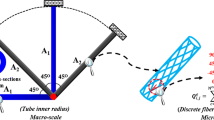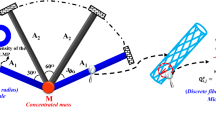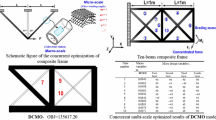Abstract
For stiffness design optimization of composite frame structures, one of the major problems when using fiber winding angles as design variables directly is the lack of convexity of the objective function, which may lead to different local optima depending on initial designs when a traditional gradient-based optimization algorithm is applied. Therefore, the present paper adopts a gradient-based two-step optimization scheme to cope with the difficulty and search for a better optimal design of composite frames in which the fiber winding angles are taken as design variables. To realize the two-step optimization scheme, the equivalent stiffness parameters of a composite beam with circular cross-section are derived in explicit expressions and used to force the convexity of the design optimization of the composite frame. The stiffness matrices are linearly expressed in terms of the stiffness parameters, which guarantee the convexity of the design variable feasible region in the stiffness parameter space. The equivalent stiffness parameters are adopted to keep invariance of physical quantities between fiber winding angle and equivalent stiffness parameter spaces. In the two-step optimization scheme, the minimum identification problem with the constraint that the objective function at the new starting point is less than or equal to the previous objective function at the optimum point in fiber winding angle space is established. Then, the two-step optimization scheme can be implemented in the fiber winding angle and structural equivalent stiffness parameter spaces, respectively, until the minimum identification problem is not possible to identify a new starting point. The proposed two-step optimization scheme for composite frames fully takes advantage of the stiffness parameters in convexity and fiber winding angles as practically physical quantities, respectively. The sensitivity information of the objective function with respect to fiber winding angles and equivalent stiffness parameters is derived by the analytical sensitivity analysis method. Numerical examples show that the two-step optimization scheme can effectively force convexity of the optimization model and help to eliminate the initial design dependency. The effectiveness of the proposed two-step scheme is further verified through the particle swarm optimization (PSO) algorithm which is an evolutionary algorithm with global optimization capability.












Similar content being viewed by others
References
Abdalla MM, Setoodeh S, Gürdal Z (2007) Design of variable stiffness composite panels for maximum fundamental frequency using lamination parameters. Compos Struct 81(2):283–291
An H, Chen S, Huang H (2015) Simultaneous optimization of stacking sequences and sizing with two-level approximations and a genetic algorithm. Compos Struct 123:180–189
Andersen ED, Roos C, Terlaky T (2003) On implementing a primal-dual interior-point method for conic quadratic optimization. Math Program 95(2):249–277
Aymerich F, Serra M (2008) Optimization of laminate stacking sequence for maximum buckling load using the ant colony optimization (ACO) metaheuristic. Compos A: Appl Sci Manuf 39(2):262–272
Bakis CE, Bank LC, Brown VL, Cosenza E, Davalos JF, Lesko JJ, Machida A, Rizkalla SH, Triantafillou TC (2002) Fiber-reinforced polymer composites for construction—state-of-the-art review. J Compos Constr 6(2):73–87
Bendsoe MP, Sigmund O (2003) Topology Optimization-Theory, Methods and Applications. Springer, New York
Birge B (2003) PSOt - a particle swarm optimization toolbox for use with Matlab. SIS 3:973–990
Bloomfield MW, Diaconu CG, Weaver PM (2009) On feasible regions of lamination parameters for lay-up optimization of laminated composites. Proceedings of the Royal Society of London a: Mathematical, Physical and Engineering Sciences, 465: 1123–1143
Bohrer RZG, Almeida SFM, Donadon MV (2015) Optimization of composite plates subjected to buckling and small mass impact using lamination parameters. Compos Struct 120:141–152
Bruyneel M (2011) SFP - a new parameterization based on shape functions for optimal material selection: application to conventional composite plies. Struct Multidiscip Optim 43(1):17–27
Bruyneel M, Fleury C (2002) Composite structures optimization using sequential convex programming. Adv Eng Softw 33(7):697–711
Byrd RH, Gilbert JC, Nocedal J (2000) A trust region method based on interior point techniques for nonlinear programming. Math Program 89(1):149–185
Chang N, Wang W, Yang W, Wang J (2010) Ply stacking sequence optimization of composite laminate by permutation discrete particle swarm optimization. Struct Multidiscip Optim 41(2):179–187
Cook RD, Malkus DS, Plesha ME, Witt RJ (2002) Concepts and applications of finite element analysis, Fourth Edition. John Wiley & Sons, New York
Davalos JF, Kim Y, Barbero EJ (1994) Analysis of laminated beams with a layer-wise constant shear theory. Compos Struct 28(3):241–253
Deng S, Pai PF, Lai CC (2005) A solution to the stacking sequence of a composite laminate plate with constant thickness using simulated annealing algorithms. Int J Adv Manuf Technol 26(5–6):499–504
Diaconu CG, Sato M, Sekine H (2002) Buckling characteristics and layup optimization of long laminated composite cylindrical shells subjected to combined loads using lamination parameters. Compos Struct 58(4):423–433
Duan ZY, Yan J, Lee IJ, Wang, JY, Yu T (2018) Integrated design optimization of composite frames and materials for maximum fundamental frequency with continuous fiber winding angles. Acta Mech Sinica 34(6):1084–1094
Faria AR (2015) Optimization of composite structures under multiple load cases using a discrete approach based on lamination parameters. Int J Numer Methods Eng 104(9):827–843
Ferreira RT, Rodrigues HC, Guedes JM, Hernandes JA (2014) Hierarchical optimization of laminated fiber reinforced composites. Compos Struct 107:246–259
Foldager J (1997) Design optimization of laminated composite plates divided into rectangular patches with use of lamination parameters, In: Gutkowski W and Mroz Z (eds): Proc WCSMO 2-second world congress of structural and multidisciplinary optimization, Inst of Fundamental Technological Research, Warsaw, Vol 2, 669–675
Foldager J, Hansen JS, Olhoff N (1998) A general approach forcing convexity of ply angle optimization in composite laminates. Struct Optim 16(2–3):201–211
Fukunaga H, Vanderplaats GN (1991) Strength optimization of laminated composites with respect to layer thickness and/or layer orientation angle. Comput Struct 40(6):1429–1439
Fukunaga H, Sekine H (1992) Stiffness design method of symmetrical laminates using lamination parameters. AIAA J 30(11):2791–2793
Ganguli R (2013) Optimal design of composite structures: a historical review. J Indian Inst Sci 93(4):557–570
Gao T, Zhang WH, Duysinx P (2012) A bi-value coding parameterization scheme for the discrete optimal orientation design of the composite laminate. Int J Numer Methods Eng 91(1):98–114
Ghiasi H, Pasini D, Lessard L (2009) Optimum stacking sequence design of composite materials Part I: constant stiffness design. Compos Struct 90(1):1–11
Ghiasi H, Fayazbakhsh K, Pasini D, Lessard L (2010) Optimum stacking sequence design of composite materials Part II: variable stiffness design. Compos Struct 93(1):1–13
Gomes FA, Senne TA (2011) An SLP algorithm and its application to topology optimization. Comput Appl Math 30(1):53–89
Grenestedt JL, Gudmundson P (1993) Layup optimization of composite-material structures. Optimal design with advanced materials. Optimal Design with Advanced Materials 311–336
Hammer VB, Bendsøe MP, Lipton R, Pedersen P (1997) Parametrization in laminate design for optimal compliance. Int J Solids Struct 34(4):415–434
Ibrahim S, Polyzois D, Hassan SK (2000) Development of glass fiber reinforced plastic poles for transmission and distribution lines. Can J Civ Eng 27(5):850–858
Jones R M (2014) Mechanics of composite materials. CRC press
Kennedy J, Eberhart RC. (1995) Particle swarm optimization. In: Proceedings of the fourth IEEE international conference on neural networks, 1942–1948
Khani A, Ijsselmuiden ST, Abdalla MM, Gurdal Z (2011) Design of variable stiffness panels for maximum strength using lamination parameters. Compos Part B 42(3):546–552
Kim Y, Davalos JF, Barbero EJ (1996) Progressive failure analysis of laminated composite beams. J Compos Mater 30(5):536–560
Kiyono CY, Silva ECN, Reddy JN (2017) A novel fiber optimization method based on normal distribution function with continuously varying fiber path. Compos Struct 160:503–515
Lei F, Qiu RB, Bai YC, Yuan CF (2018) An integrated optimization for laminate design and manufacturing of a CFRP wheel hub based on structural performance. Structural and Multidisciplinary Optimization, 1–13
Liu B, Haftka RT (2004) Single-level composite wing optimization based on flexural lamination parameters. Struct Multidiscip Optim 26(1–2):111–120
Liu ST, Hou YP, Sun X, Zhang YC (2012a) A two-step optimization scheme for maximum stiffness design of laminated plates based on lamination parameters. Compos Struct 94(12):3529–3537
Liu XF, Cheng GD, Yan J, Jiang L (2012b) Singular optimum topology of skeletal structures with frequency constraints by AGGA. Struct Multidiscip Optim 45(3):451–466
Liu DZ, Toropov VV, Barton DC, Querin QM (2015) Weight and mechanical performance optimization of blended composite wing panels using lamination parameters. Struct Multidiscip Optim 52(3):549–562
Lund E, Stegmann J (2005) On structural optimization of composite shell structures using a discrete constitutive parametrization. Wind Energy 8(1):109–124
Miki M (1982) Material design of composite laminates with required in-plane elastic properties. Proc Progress in Science and Engineering of Composites, ICCM IV, Tokyo
Nikbakt S, Kamarian S, Shakeri M (2018) A review on optimization of composite structures part I: laminated composites. Compos Struct 195:158–185
Przemieniecki J S (1985) Theory of matrix structural analysis. Courier Corporation
Riche RL, Haftka RT (1993) Optimization of laminate stacking sequence for buckling load maximization by genetic algorithm. AIAA J 31(5):951–956
Schütze R (1997) Lightweight carbon fibre rods and truss structures. Mater Des 18(4–6):231–238
Setoodeh S, Abdalla MM, Gürdal Z (2006) Design of variable–stiffness laminates using lamination parameters. Compos Part B 37(4–5):301–309
Sigmund O (2001) On the usefulness of non-gradient approaches in topology optimization. Struct Multidiscip Optim 43(5):589–596
Stegmann J, Lund E (2005) Discrete material optimization of general composite shell structures. Int J Numer Methods Eng 62(14):2009–2027
Svanberg K (1987) The method of moving asymptotes – a new method for structural optimization. Int J Numer Methods Eng 24:359–373
Thuwis GA, Breuker RD, Abdalla MM, Gürdal Z (2010) Aeroelastic tailoring using lamination parameters. Struct Multidiscip Optim 41(4):637–646
Todoroki A, Terada Y (2004) Improved fractal branch and bound method for stacking-sequence optimizations of laminates. AIAA J 42(1):141–148
Tsai SW, Pagano NJ (1968) Invariant properties of composite materials. No. AFML-TR-67-349. Air Force Materials Lab, Wright-Patterson AFB, Ohio
Venkataraman S, Haftka RT (1999) Optimization of composite panels - a review, proceedings of the American Society for Composites – 14th annual technical conference, Fairborn, Ohio, 479–488
Xu YJ, Zhu JH, Wu Z, Cao YF, Zhao YB, Zhang WH (2018) A review on the design of laminated composite structures: constant and variable stiffness design and topology optimization. Advanced Composites and Hybrid Materials,1–18
Yan J, Duan ZY, Lund E, Wang JY (2017) Concurrent multi-scale design optimization of composite frames with manufacturing constraints. Struct Multidiscip Optim 56(3):519–533
Acknowledgments
The authors thank Prof. Bin Niu for checking the correctness of the formula derivation.
Funding
Financial supports for this research were provided by the National Natural Science Foundation of China (Nos. 11672057,11711530018 and 11732004), the National Key R&D Program of China (2017YFC0307203), Program (LR2017001) for Innovative Talents at Colleges and Universities in Liaoning Province, the 111 project (B14013), the Korea Institute of Energy Technology Evaluation and Planning, and the Ministry of Trade Industry & Energy of the Republic of Korea (No. 20172010000830).
Author information
Authors and Affiliations
Corresponding authors
Additional information
Responsible Editor: Emilio Carlos Nelli Silva
Publisher’s Note
Springer Nature remains neutral with regard to jurisdictional claims in published maps and institutional affiliations.
This work has been presented on 21st International Conference on Composite Materials Xi’an, 20-25th August 2017
Rights and permissions
About this article
Cite this article
Duan, Z., Yan, J., Lee, I. et al. A two-step optimization scheme based on equivalent stiffness parameters for forcing convexity of fiber winding angle in composite frames. Struct Multidisc Optim 59, 2111–2129 (2019). https://doi.org/10.1007/s00158-018-2179-9
Received:
Revised:
Accepted:
Published:
Issue Date:
DOI: https://doi.org/10.1007/s00158-018-2179-9




